Monolithic arbolite is one of the most economical building materials ...
|
|
The attic floor is subjected to large heat loss compared to other parts ... |
The days passed when the glass ceiling was exclusively a prerogative of discos ... |
Warm floor in a bath with your own hands
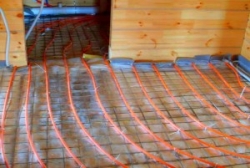
Many people like to take a steam bath in a Russian bath, whip themselves with an oak or birch broom, and even drink Russian bread kvass. And after visiting a hot bath, you can swim in the hole and walk barefoot. It is natural after the construction of the bath in their site that the owners should decide what the floor is in the room, and even choose the method of floor insulation. Once upon a time, construction felt was used as a heater, and in order to increase its service life, the substance was subjected to bitumen impregnation. Nowadays, these functions perform warm floors in the bath.
Table of contents:
- The occurrence of a warm floor
- Floor insulation in the bathhouse
- Water warm floor in the bath
- Electric warm floor
- Laying cable floor in the bath
- Coatings for a warm floor in a bathhouse
The occurrence of a warm floor
Since ancient times, it was customary to build wooden baths in Russia. They were built very quickly and with small costs. They brought logs, laid them directly on the basis and can be built. Then it was customary to put wooden Russian baths without a foundation. It began to be used in construction later in the 18-19 centuries.
The bathhouse on the foundation costs much longer, since the first tier of logs laid on the ground does not rot. Also, the floor can be made warm, not cold. In ancient times, when they built a Russian bathhouse, logs split in half were laid on the ground, it was the floor that served faithfully. But from constant moisture and damp, wooden floors in the bathhouse begin to rot, and they were constantly being repaired.
An excellent alternative to the wooden floor was concrete. In advance, you need to give the necessary slope to the concrete floor to drain water to a certain place, to collect and drain it into the cesspool and then for sending to sewer drains. Very rarely, concrete floors in a Russian bath were covered with boards or mats that create comfortable conditions. However, despite this, the best solution for you will be a warm floor in the bathhouse.
Such a system successfully performs the functions assigned to it, is not afraid of orphans, even, but it also has a large drawback of such floors cold. Having stood on such a half -barefoot, you will immediately feel the cold: this is not a very pleasant feeling, especially if children use the bath. In order to get out of such an unpleasant situation, there is a very competent solution.
Now there are many varieties of warm floors for the bathhouse on the market. You can make them with electric heating, rod, cable, film or water heating. Hot water is supplied to the pipes laid in the floor, so such a floor will always be warm. However, before the installation of a warm floor, you should get acquainted with the main types of systems that are available on sale, see the photo selection and video offered by us.
Floor insulation in the bathhouse
Nowadays, there are expedents, felt, basalt and other substances for floor insulation in the bathhouse. We have this material between the layers of concrete. If the floors are made on the lags, then between them. The thickness of the insulating layer should not exceed 15 centimeters. If desired, you can make thicker. The use of expanded clay flooring in the steam room allows you to create additional ventilation. However, it should be remembered about additional waterproofing.
- There are cases when gender insulation in the Russian steam room does not give the desired result. Then you have to arrange warm floors for the bath. There are two varieties of warm floors:
- A warm water floor, functioning in a similar method as radiators;
- Warm electric floor, which differs on the principle of heating: infrared and convection, in execution: rod, cable and film.

Water warm floor in the bath
To make a warm water floor in a bath, you can use polyethylene, steel or metal -plastic pipes. This design consists of a schematic wiring of pipes, which are between the base and coating. The following coolants can be used except water: antifreeze, special solutions, ethylene glycol.
To have the smallest heat loss, the pipes are laid on a special heat -insulating material. For high -quality improvement of heat transfer, the pipes are laid on aluminum foil. Two main ways of laying pipes with a snail and a snake are distinguished. The first method is the most easy to install. The second allows the heat to be distributed more uniformly on the system.
There are several options for arranging water heating for the bath: installing floors on a wooden base, installing pipes with a concrete mixture, the use of polystyrene plates with grooves and laying in pipes.
Water warm floor in the bathhouse has the following advantages:
- the heating system is inside the floor;
- the possibility of creating heat on a significant area with small expenses;
- uniform distribution of heat over the entire area of \u200b\u200bthe room;
- big savings on energy resources compared to electric.
But also the system of water floors laid in the steam room has its drawbacks:
- complexity in the installation;
- the need for the use of a water pump;
- complexity when changing the temperature regime;
- when leaking, it is very difficult to find a source.
Electric warm floor
When installing an electric warm floor in the bath, be prepared that electricity consumption will increase. Despite this, such floors have many significant advantages. Let's get acquainted in more detail with each type of electric warm floor. All of them have their advantages, inconvenience in the installation in the steam room and even disadvantages. Some of them are more advisable not to lay in the steam room itself, but in the washing room, rest room or dressing room.
Convection cable floor
The convection cable floor consists of a heating cable laid on the mesh base. Such a floor is sold in rolls. Its installation in the bath is a very complex process that it is better to entrust the masters. Among the advantages of the convection cable floor, the following can be distinguished: the ability to control the temperature automatically and the possibility of laying for any coating. However, such a system is completely dependent on energy supply and provokes large electricity costs.
Film infrared floor
In its range, infrared radiation is similar to the sunny. However, it does not have a harmful effect of ultraviolet radiation, which positively affects the guests of the bath. A film electric floor is made of thin flexible stripes of carbon material with a size of 0.3 milimeters, which is securely sealed in a polymer film.
By installing a film warm floor for a bath, they put a heat -reflecting material on the base, for example, isolon. The constituent elements of the system are laid out on it, and plastic film is placed on top. It is needed to create waterproofing of heating elements. And mount the flooring at the finish line.
The advantages of a film warm floor lies as follows:
- with proper installation of the system, the failure is almost excluded;
- the elements are connected in parallel, so the breakdown of one segment at the work of others will not affect;
- in such elements, infrared radiation is used, it is very useful for humans;
- there are no different electromagnetic radiations;
- you can lay under heavy flooring, such as porcelain tiles and ceramic tiles.
However, infrared film warm floor is characterized by one significant drawback - weak moisture resistance, so such a floor in the bath is not suitable for washing.
Red infrared floor
The rod infrared elements are also called mats. In them heating elements are rods that are connected to the supply wires. Such compounds are made in parallel, the failure of one element will not entail the failure of all the others. In appearance, infrared mats look like a rope staircase. The installation of such floors is carried out in a cement screed or in tile glue.
The advantages of using a rod warm floor in a bathhouse: it does not generate electromagnetic radiation and is not afraid of overheating, it is not scary to lock furniture. But along with this, there are shortcomings: dependence on electricity and the high cost is not justified.
Laying cable floor in the bath
Installation of a cable electric floor for a bath implies the presence:
- specialist. equipment, which includes two- and single-core cables, also the presence of special metal nets, which show and set the direction of installation;
- thermal insulation material, it is usually possible to use foamed polyethylene or cork plates (foamopylene);
- if plates from traffic jams are used for thermal insulation, then foil must be used to ensure reliable fire safety.
In order to make installation on the floor, it must be perfectly clean and even. A special thermal insulation material is laid on such a floor. Special control requires the installation of such a floor for a bath on a surface of wood. The wire in this case is laid strictly on top of a special metal mesh: this is necessary to isolate from the coating.
After that, guides are installed. In advance, before laying the heating cable, its resistance is measured to make sure of serviceability. The resistance of the wire must correspond to the specified values \u200b\u200bin the documentation that should be attached to this mounting kit.
The heating cable is laid along the special guides, pulling it slightly. In any case, he should not bend or twist. The visually heating cable is very similar to a regular electric, but it is intended for converting electric current into heat.
One- and two-core cable usually differs in the level of electromagnetic radiation. In a two -wire cable, the radiation is less than five times less and does not exceed this indicator of the established norms. The installation of a two -wire cable does not need to supply the second end to the thermostat for the second end, so it is much easier.
After laying the cable, the thermostat is installed and connected to it. With the help of it, the level of heating of the floor is controlled. It is recommended that it be mounted next to the wiring. The temperature sensor is usually isolated by a corrugated tube and is, as a rule, at the same level with a screed of concrete. All this is done so that its replacement in the event of failure does not constitute much difficulty for the owner of the bathhouse.
Coatings for a warm floor in a bathhouse
After the arrangement of the warm floor in the bathhouse, we should not forget about the great importance of the correct arrangement of the upper coating. Not only the appearance of the bath, but also the sanitary condition of the room will depend on this. You can use: as a floor covering in the bath:
- traditional ceramic tiles, which has excellent thermal conductivity, is not at all afraid of sudden temperature drops, is easily washed and has a fairly long period of useful service;
- parquet coating for the dressing room, if treated with protective equipment;
- laminate for laying on lightweight floors;
- linoleum with anti -slip coating as the most budget option.
After the cable has been laid and the thermostat was connected to it. The floor is concrete. Next, the flooring is applied to it (linoleum, tiles, etc.). If the room is irregularly heated, it is best to use glass tiles or porcelain tiles. Linoleum has much less heat transfer and is not as energy -intensive as tiles.
In addition, you need to know that some types of linoleum when heated are very toxic. Wood coating is one of the worst thermal conductors, and with frequent and prolonged wetting and drying, the wood is very deformed and crackled. This coverage option is unacceptable for the insulated floor.
If the bathhouse is heated constantly, the best type of coating for its floor will be wastewater or tiles. These finishing materials have the greatest thermal conductivity, which will significantly save the cash cost of electricity. You need to turn on the floor only after it completely hardens. For concrete, the term should be at least 10 days.
Thus, any type of warm floors in the bathhouse has its advantages and disadvantages. Knowing all this, you will make a conscious choice. The device of warm concrete floors in a bathhouse in which water is a coolant allows you to save on electricity. Electric warm floors are very easy to install and operate, but they are very dependent on energy supply and also much increase the cost of electricity.

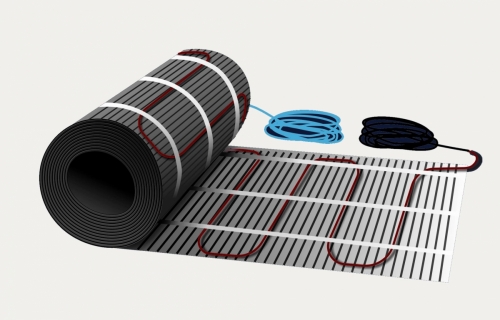
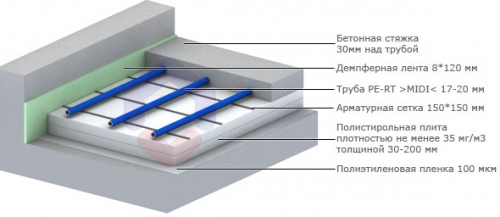
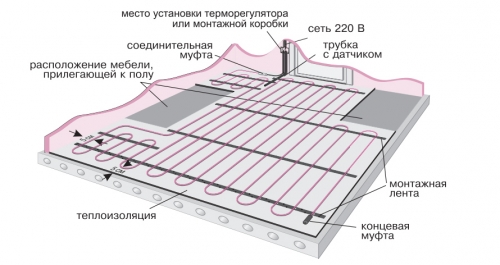
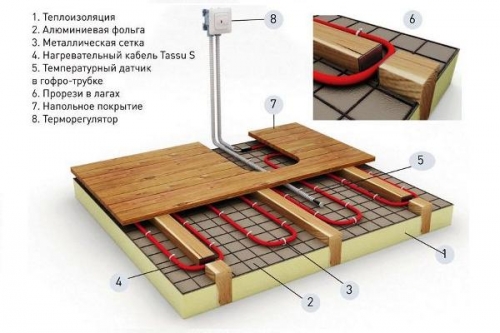
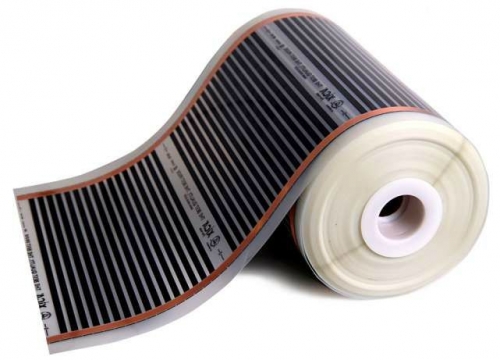
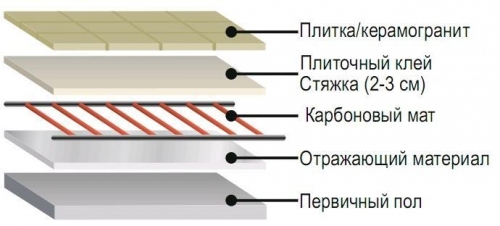
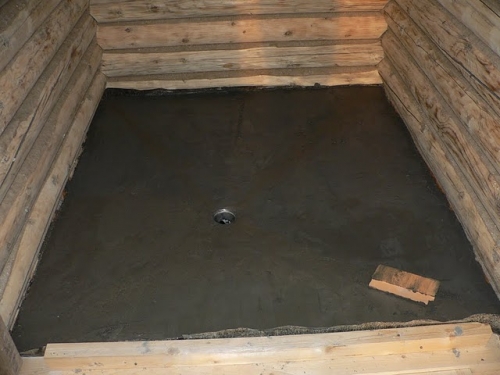
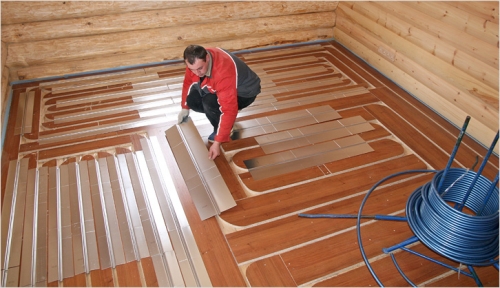
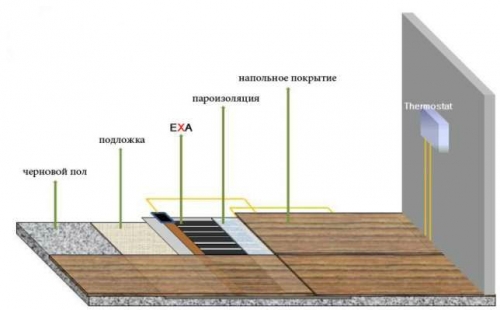
Very good and
A very good and informative article. The only thing, it seems to me that there is no better wooden floor for the bathhouse. I mean - for my own bathhouse.
So I was looking for how to do
So I was looking for how to make warm floors for an ordinary village bath, and not this scientific and technical thought